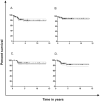Long-term outcome of pediatric patients with severe aplastic anemia treated with antithymocyte globulin and cyclosporine
- PMID: 18672253
- PMCID: PMC3971527
- DOI: 10.1016/j.jpeds.2008.06.004
Long-term outcome of pediatric patients with severe aplastic anemia treated with antithymocyte globulin and cyclosporine
Abstract
Objective: To determine the long-term outcomes in children with severe aplastic anemia (SAA) treated with antithymocyte globulin (ATG) and cyclosporine (CsA) through a retrospective analysis of the pediatric patients treated at our institution in all protocols that included horse ATG (h-ATG) and CsA.
Study design: Between 1989 and 2006, a total of 406 patients, 20% of whom were children under age 18 years, received an initial course of immunosuppressive therapy (IST) at our institution. Here we report the outcome of 77 children who were treated with an h-ATG plus CsA-based regimen during this period.
Results: The overall response rate at 6 months was 74% (57/77); the cumulative incidence of relapse at 10 years was 33%, and the median time to relapse was 558 days. The cumulative incidence of evolution after IST was 8.5%; all 3 such events occurred in partial responders. Overall, there were 13 deaths (17%), with 4 occurring within the 3 months after IST in patients who had a pretreatment absolute neutrophil count of < 100/microL and the other 9 occurring more than 6 months after initiation of IST. The median time to death was 570 days. The overall 10-year survival for the entire cohort was 80%; long-term survival in the children who responded to IST was 89%.
Conclusions: The long-term survival in pediatric patients who respond to IST is excellent, at about 90%. IST remains a good alternative in pediatric patients who lack an HLA-matched sibling donor and should be offered as initial therapy before possible hematopoietic stem cell transplantation from an unrelated donor.
Conflict of interest statement
The authors disclose no conflicts of interest.
Figures




References
-
- Alter BP, Young NS, Nathan DG, Oski FA. Hematology of Infancy and Childhood. Philadelphia: W.B. Saunders Company; 1993. The bone marrow failure syndromes; pp. 216–316.
-
- Fogarty PF, Yamaguchi H, Wiestner A, Baerlocher GM, Sloand EM, Zeng W, et al. Late presentation of dyskeratosis congenita as apparently acquired aplastic anaemia due to mutations in telomerase RNA. Lancet. 2003;362:1628–30. - PubMed
-
- Gillio AP, Verlander PC, Batish SD, Giampietro PF, Auerbach AD. Phenotypic consequences of mutations in the Fanconi anemia FAC gene: an International Fanconi Anemia Registry study. Blood. 1997;90(1):105–10. - PubMed
-
- Yamaguchi H, Calado RT, Ly H, Baerlocher GM, Kajigaya S, Chanock SJ, et al. Mutations in TERT, the gene for telomerase reverse transcriptase, in aplastic anemia. N Eng J Med. 2005;352:1413–24. - PubMed
-
- Horowitz MM. Current status of allogeneic bone marrow transplantation in acquired aplastic anemia. Seminars in Hematology. 2000;37:30–42. - PubMed
Publication types
MeSH terms
Substances
Grants and funding
LinkOut - more resources
Full Text Sources
Other Literature Sources
Medical
Research Materials

